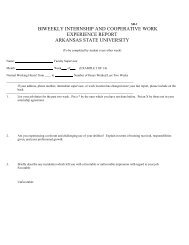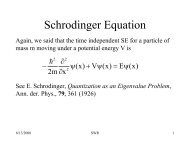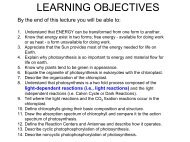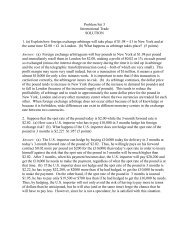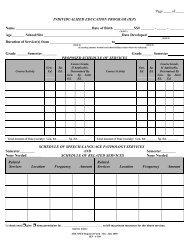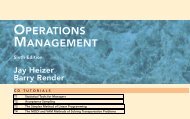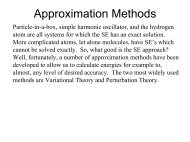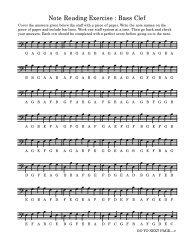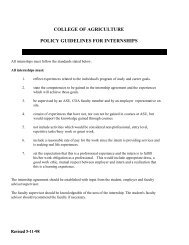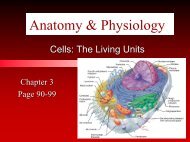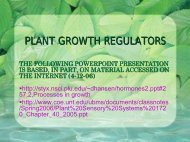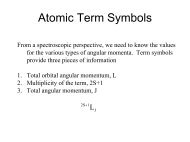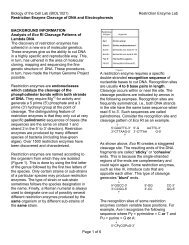ancmat02.qxd 11/16/06 3:25 PM Page B4B4 • SUPPLEMENT BINTRODUCTION TO OPTIMIZATIONALGEBRAIC FORMULATION FormulationA formal, algebraic statemen<strong>to</strong>f a constrained optimizationproblem.The text description of the problem is fine for communicating a general understanding,but in order <strong>to</strong> address the problem using optimization we need <strong>to</strong> develop a formalalgebraic description, called a formulation. A formulation contains explicitdefinitions of the decision variables, an algebraic expression of the objective function,and algebraic statements of the constraints. This is not as hard as it sounds, but it is acrucial step if you hope <strong>to</strong> develop a high-quality spreadsheet model that Solver cansuccessfully solve.A diagram of the situation can help <strong>to</strong> structure the problem so that the algebraicformulation can be written down more easily. A well-constructed diagram is also avaluable communication <strong>to</strong>ol. In this situation, three resources are combined <strong>to</strong> producetwo products. Specific amounts of each resource are needed, and each productgenerates a known profit. See Figure B-2 for one way <strong>to</strong> show this. One of the importantpoints is that the <strong>to</strong>tal amount of each resource available must be shared betweenthe two products (assuming both are <strong>to</strong> be produced).A diagram, coupled with a text-based formulation, often serves as a valuable steppings<strong>to</strong>ne <strong>to</strong> a formal algebraic formulation. In this situation, a text-based formulationcan be stated as follows:Text-Based Formulation● Decision variables: Number of camshafts <strong>to</strong> make, number of gears <strong>to</strong> make● Objective function: Maximize profit● Constraints: Must not exceed our resource availability in steel, labor, and machinehoursThe text-based formulation helps <strong>to</strong> structure the problem. The next step is <strong>to</strong>write the algebraic formulation. The algebraic formulation states the decision variables,objective function, and constraints in algebraic terms. The decision variablescorrespond <strong>to</strong> the quantities of camshafts and gears <strong>to</strong> make. We do not know aheadof time the best values for these (that’s what we’re trying <strong>to</strong> determine), so we create avariable <strong>to</strong> represent each quantity, as follows:FIGURE B-2DJJ Enterprises diagramRawMaterialsLaborMachineTime5 lb8 lb1 hr 3 hr 4 hr 2 hrCamshafts($25/unit)Gears($18/unit)
ancmat02.qxd 11/16/06 3:25 PM Page B5Decision VariablesC number of camshafts <strong>to</strong> makeG number of gears <strong>to</strong> makeThe actual names of the decision variables are not crucial (some people prefer X 1 andX 2 , for example); however, it is helpful <strong>to</strong> name the variables so the names remind youof the quantities they represent.The next step is <strong>to</strong> write the objective function in terms of the decision variablesjust defined. The objective function is simply an expression that determines howmuch profit will be earned if C camshafts are made and G gears are made. We also indicatewhether we want <strong>to</strong> maximize (“Max”) or minimize (“Min”) the objectivefunction. Since we know the unit profits of each, the objective function isALGEBRAIC FORMULATION • B5Objective FunctionMax 25C 18G (profit, $)It is good practice <strong>to</strong> include the units and the quantity represented by the objectivefunction, as shown in parentheses.Finally, we need <strong>to</strong> write expressions for the constraints. In this example, we arelimited by the amounts of the resources—steel, labor, and machine time—available.For steel, we know that 5000 pounds are available. We also know that each camshaftuses 5 pounds, and each gear uses 8 pounds. Therefore, if we make C and G camshaftsand gears, respectively, it will require 5C 8G lb of steel. In order for this product mix<strong>to</strong> be possible, this combined <strong>to</strong>tal must not exceed 5000 pounds. We write this inmathematical terms as follows:5C 8G 5000 (steel, lb)Using similar logic, we write the constraints for labor and machine time. Convinceyourself that these constraints should be written as1C 4G 1500 (labor, hr)3C 2G 1000Each of these constraints is a less-than-or-equal-<strong>to</strong> constraint. A constraint canalso be a greater-than-or-equal-<strong>to</strong> constraint or an equality constraint. A problemcan have a mix of these constraint types. For example, it could be that we are required<strong>to</strong> produce at least a certain number of camshafts and gears combined ( constraint).Alternatively, perhaps we want <strong>to</strong> force our solution <strong>to</strong> use exactly 1500 labor hours( constraint). Strict inequalities (, ) are not used in optimization problems; thethree constraint relationship types are , , and .There are two additional constraints that initially may not seem required. Theyforce each of the decision variables <strong>to</strong> remain nonnegative, that is, greater than orequal <strong>to</strong> zero. We refer <strong>to</strong> these as the nonnegativity constraints. From a businesssense we know that we cannot produce negative quantities of camshafts and gears.However, neither a mathematical model nor a spreadsheet model “knows” these seeminglyobvious things. These constraints are written:C 0G 0(machine time, hr)Most of the time, these would be written <strong>to</strong>gether asC, G 0 (nonnegativity) Less-than-or-equal-<strong>to</strong>constraintA constraint such as 3x 1 5x 2 22, often used <strong>to</strong> modela limitation on the amount ofa resource that can be used. Greater-than-or-equal-<strong>to</strong>constraintA constraint such as 4x 1 7x 2 50, often used <strong>to</strong>model a requirement thatmust be satisfied. Equality constraintA constraint such as 6x 1 3x 2 30, used <strong>to</strong> specifythat a requirement mustbe met exactly. Nonnegativity constraintsConstraints of the form x 1 0, which are nearly universal inlinear programming problems.They are used <strong>to</strong> represent thefact that negative quantities ofproducts cannot be made,shipped, etc.



